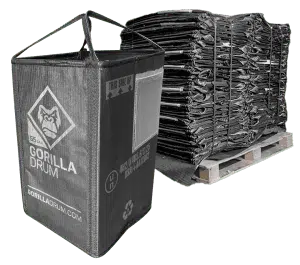 When it comes to hazardous waste management, choosing the right containment solution is critical. Traditional 55 gallon hazmat drums have been the industry standard for decades, but new innovations are transforming how hazardous materials are stored, handled, and transported. Modern drum alternatives offer safer, lighter, and more efficient ways to contain hazardous liquids and solids without compromising on compliance or durability.
When it comes to hazardous waste management, choosing the right containment solution is critical. Traditional 55 gallon hazmat drums have been the industry standard for decades, but new innovations are transforming how hazardous materials are stored, handled, and transported. Modern drum alternatives offer safer, lighter, and more efficient ways to contain hazardous liquids and solids without compromising on compliance or durability.
Gorilla Drum leads this evolution with advanced drum alternatives designed for performance and safety. These collapsible, UN and DOT compliant containers offer a better approach to hazardous waste management while maintaining the same reliability as traditional drums.
Why Drum Alternatives Are Gaining Popularity
Traditional steel and plastic hazmat storage drums have limitations. They are bulky, heavy, and take up valuable warehouse space, even when empty. They also require costly cleaning or disposal once contaminated. Many facilities are now adopting collapsible drum alternatives that combine safety, efficiency, and sustainability.
These modern solutions handle hazardous waste just as effectively as conventional containers but with added benefits such as reduced storage footprint, easier transport, and faster setup.
For a complete overview of traditional and alternative drum designs, see the 55 Gallon Drum Options For Hazardous Material Disposal resource.
How Drum Alternatives Handle Hazardous Liquids
Hazardous liquids—such as flammable, corrosive, or toxic chemicals—require containers that prevent leaks, spills, and vapor release. Drum alternatives like Gorilla Drum are engineered to meet these challenges while improving efficiency.
Leakproof and Chemical-Resistant Construction
Modern drum alternatives are made from durable, chemical-resistant polypropylene or similar materials. This construction resists corrosion, punctures, and degradation from aggressive liquids such as acids, solvents, and industrial chemicals.
Their reinforced structure and sealed zipper closures ensure that hazardous liquids remain fully contained during storage and transport. Unlike rigid steel drums that can rust or deform under pressure, flexible drum alternatives maintain integrity under varying conditions.
Secure Containment and Transport
Drum alternatives are tested to the same standards as UN rated hazmat drums and DOT approved hazmat containers. They undergo rigorous drop, stacking, and hydrostatic pressure tests to confirm they can safely transport hazardous liquids without leaking or rupturing.
Additionally, their design includes integrated support systems that prevent bulging and maintain drum shape even under heavy load. The combination of flexibility and structural support ensures safety during movement and handling.
Easy Handling and Reduced Weight
Liquid-filled steel drums can weigh several hundred pounds, making them difficult to handle. Drum alternatives are significantly lighter, reducing strain on workers and minimizing the need for specialized equipment. Lift loops, dolly straps, and ergonomic grips make them easier to move safely, even when full.
How Drum Alternatives Handle Hazardous Solids
Hazardous solids and sludges pose different containment challenges than liquids. These materials can be dense, abrasive, or moisture-sensitive, requiring containers that resist tearing and maintain stability.
Drum alternatives are designed to meet these needs while offering the same level of protection as a traditional hazardous waste drum.
Strength and Durability
Drum alternatives feature reinforced sidewalls, heavy-duty stitching, and multi-layered fabric that supports high-density solids without deformation. This allows them to safely contain contaminated soil, powders, resins, or solidified sludge.
Each drum is engineered to handle substantial weight loads while maintaining its shape during transport and storage. For added stability, they often include internal frames or belly bands that distribute pressure evenly across the container.
Dust and Contamination Control
Many hazardous solids create airborne dust during handling. Drum alternatives with tight-sealing closures and zipper lids prevent dust release and cross-contamination. This helps maintain clean work environments and reduces exposure risks for workers.
Simplified Disposal and Replacement
Once emptied, traditional steel or plastic drums require costly cleaning or disposal. Collapsible drum alternatives can be easily compacted and stored for reuse or replacement, saving both space and time. Their lightweight materials also reduce waste management costs while supporting sustainable operations.
The Benefits of Drum Alternatives for Hazardous Waste Management
Drum alternatives provide numerous advantages over conventional hazmat barrels and chemical barrels, especially for facilities managing large volumes of waste.
Space and Storage Efficiency
One of the biggest advantages of collapsible drums is their ability to fold flat when not in use. A warehouse that could previously hold 20 steel drums can now store hundreds of folded alternatives in the same space. This drastically reduces storage costs and improves logistical efficiency.
Compliance and Safety
Drum alternatives meet or exceed UN and DOT safety requirements. They are tested for chemical compatibility, impact resistance, and stacking strength, ensuring compliance for both domestic and international transport.
Environmental and Economic Benefits
Reusability and recyclability make drum alternatives a more sustainable choice. Their reduced weight lowers shipping costs, while their reusable design minimizes the number of single-use containers entering the waste stream.
These factors align with growing environmental initiatives aimed at reducing industrial waste and improving sustainability practices.
Choosing the Right Drum for Your Waste Type
Selecting the right drum or container depends on the characteristics of the material being stored. Key considerations include:
-
Physical state (liquid, solid, sludge, or powder)
-
Reactivity or corrosiveness
-
Temperature and storage conditions
-
Regulatory classification (hazard class and packing group)
-
Handling and transport methods
For professional guidance on selecting the appropriate container, review the Guide To Choosing The Right Hazmat Drums For Waste Storage. This resource provides detailed recommendations for choosing compliant containers based on material compatibility and handling needs.
Why Gorilla Drum Is a Superior Drum Alternative
Gorilla Drum has redefined chemical drum storage with its advanced, collapsible design. Made from high-strength polypropylene, Gorilla Drum is engineered to safely contain both hazardous liquids and solids.
Key features include:
-
Collapsible frame for compact storage and easy transport
-
Reinforced zipper lid for leak and spill prevention
-
Integrated structure for stability under heavy loads
-
Lightweight design for easy handling
-
Compliance with UN and DOT hazardous materials standards
Whether used as a primary hazardous waste drum or as an alternative to bulky steel and plastic drums, Gorilla Drum provides a safer, more efficient solution for hazardous material containment.
Final Thoughts
Drum alternatives are changing the future of hazardous waste management. With improved safety, easier handling, and a more sustainable design, they outperform traditional 55 gallon drums for hazardous waste in almost every category.
By adopting collapsible, compliant solutions like Gorilla Drum, facilities can reduce costs, improve storage efficiency, and maintain full regulatory compliance.
To learn more about safe and efficient drum alternatives for hazardous liquids and solids, call +1 800-758-8079.

